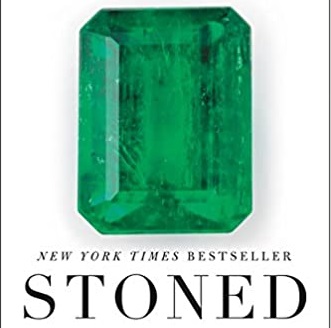Stoned: The Exact Right Book for all Gemstone and Geology Lovers

Right from the title, you know you’re in for a good time.
Aja Raden’s Stoned: Jewelry, Obsession, and How Desire Shapes the World is written in the irreverant but informative tone that turns otherwise dry, academic facts fun. And yet it doesn’t treat its subject lightly: this book is dense with geology, gemology, history, politics, economics, sociology, and human drama. Few people could pull off writing a book like this. Aja makes it look easy breezy lemon squeezy.
So, yes, you’re going to enjoy yourself, but you’re also going to come out with your knowledge raised to critical nerdicality levels, so be prepared.
Aja hits the famous gemstones like diamonds and emeralds, of course, but there are some surprising inclusions, too. She starts her survey with glass beads. It may seem strange to talk about those when we’re supposed to be on the subject of gemstones, but it’s a masterful choice. Beads perfectly illustrate the fact that gems are only really precious because we want them, and their value is almost entirely man-made. By the end of the chapter, you’ll understand why Native Americans in what would become New York State were perfectly satisfied with trading land rights to the Dutch for glass beads. She doesn’t dismiss the fact that Europeans often exploited indigenous people, but shows how this particular deal was acceptable to all parties at the time. She also shows how beads were used as currency before Europeans even landed on American shores, so this was a recognized form of payment. And then she shows how the Dutch made a bad deal with the British that basically saw New Amsterdam traded for nutmeg – which would actually have been a perfectly fine deal if not for a few odd occurrences.
History is weird, people are complex, and Aja is talented at explaining it all.
She busts a lot of myths. For instance: the scarcity of diamonds. Yeah, no, that was completely engineered. Mythical city of El Dorado? Not a real myth, but PR. Pretty much every chapter likewise skewers some taken-for-granted beliefs, and it’s marvelous.
The chapter on emeralds takes us from the geology of the gemstones, through their value to ancient civilizations, and shows how Spain’s greedy pillaging of the New World caused their value to plummet drastically. There’s also some acerbic social commentary on how Spaniards and Columbus treated the native folks whose emeralds those actually were.
The chapter on Marie Antoinette’s diamond necklace is a rollicking historical tale, filled with fraud, greed, palace intrigues, revolution, and enough sparkly stones to bankrupt a nation. Marie comes out of this as a whole, sympathetic human who wasn’t at all as horrible as people would like to believe. And “her” necklace? Never actually hers. She didn’t even want the bloody thing. The diamonds themselves are pretty great, though.
Pearls get two fascinating chapters. In the first, we get to gawk at some serious sibling rivalry, and learn how a gigantic pearl sort of indirectly led to Elizabeth I becoming basically a pirate queen. It’s a captivating vignette of the times, and does a marvelous job of showing how valuable pearls once were due to their scarcity and the difficulty in diving for pearl oysters in an age before scuba gear.
Pearls’ second appearance takes us to Japan, where a noodle maker dreamed of making pearls available to every woman in the world. His wife, a samurai’s daughter, fully supported his ambitions. And when disaster struck, she kept his dream alive. Thus, cultured pearls were born.
Both chapters are absolutely riveting. And look, I know they’re more to do with biology than geology, but you’ll probably love them anyway.
The tragic story of Fabergé eggs is told in another chapter. Wealth, royalty, craftsmanship, and incredible beauty all get destroyed by war. The eggs are described in such exquisite detail that even if you, like me, had absolutely no use for them before, you’ll be enchanted by them in the end. And there are so very many sparkly gemstones involved!
Then there’s the startling true story of wristwatches, which were considered too womanly to manly-men until war made dudes realize that no, these things are actually really freaking handy! This chapter also explores humanity’s relationship with time and the measuring thereof, and why we we humans are so fascinated by jewelry.
By the end of this book, you’ll be a much more educated human, but you won’t notice the process of becoming so because you’ll be so vastly entertained. I seriously can’t recommend it highly enough.
For a free chaser, you can delve into one of the books Aja used as a source: Mrs. Goddard Orpen’s Stories About Famous Precious Stones. It talks about some of the most famous jewels in history, some of which you’ve probably heard of and some that never pinged your radar. Its historical accuracy will need to be taken with a grain of salt, but it’s still a very interesting read.

Rosetta Stones and Dana Hunter’s Unconformity wouldn’t be possible without you! If you like my content, there are many ways to show your support.
This website is a member of the Amazon Affiliates program. I get a small commission when you use my affiliate link to make a purchase.
Thank you so much for your support!




